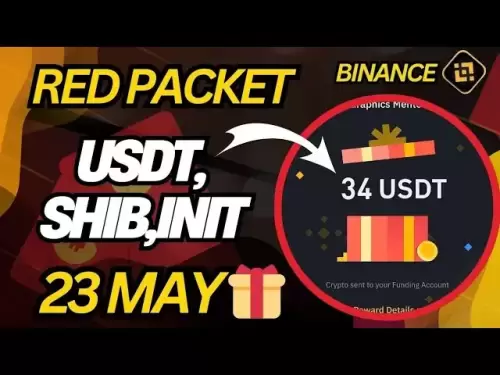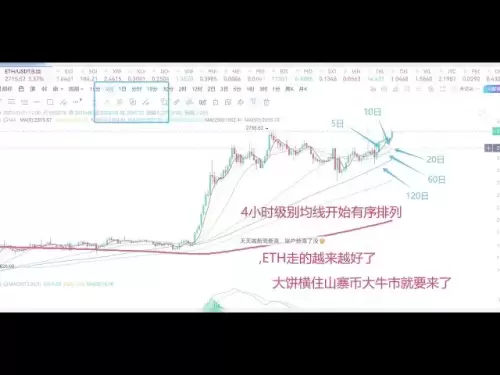 |
|
 |
|
 |
|
 |
|
 |
|
 |
|
 |
|
 |
|
 |
|
 |
|
 |
|
 |
|
 |
|
 |
|
 |
|
Cryptocurrency News Articles
Vitalik Buterin’s Latest Rethink on Ethereum Layer 2s Has Reignited Debate
May 22, 2025 at 03:18 am
Vitalik Buterin’s latest rethink on Ethereum Layer 2s has reignited debate around scalability and network complexity. Meanwhile, Solaxy – a Layer 2 solution built on Solana – has surged past $38 million in presale funding. Could it be the best crypto presale of 2025?

Vitalik Buterin, the co-founder of Ethereum, has sparked fresh debate about Layer 2 (L2) networks with his latest comments on the trade-offs involved in simplifying Layer 1 at the expense of more complicated L2s.
Buterin took to X, formerly Twitter, to share his shifting perspective on a critical aspect of scaling solutions. Over five years ago, he was three times less confident in the idea of simplifying Layer 1 even at the expense of more complicated L2s.
“The argument was that L2s offer better scalability, but at the cost of introducing new types of risks. For example, if a L2 has a bug, the consequences could be severe and permanent, while bugs in L1 are usually survivable because the network can agree to halt and make changes.”
This shift in Buterin’s thinking follows years of Ethereum’s focus on enhancing Layer 2 scalability. Buterin now proposes a more balanced approach, integrating advanced features at the Layer 1 level to reduce the burden placed on Layer 2s, ultimately creating a safer and more efficient ecosystem.
He further explained the risks, stating that when Layer 1 fails, developers quickly band together to fix the issue, but if a Layer 2 fails, users could lose their funds permanently.
This statement from Buterin marks a pivot from his earlier optimism toward Layer 2s as the primary scaling solution. It underscores the pressing need to address both security and functionality at both levels of the Ethereum network.
As the conversation around L2 solutions deepens, emerging networks are being closely examined for their ability to balance modularity, performance, and security in a rapidly changing blockchain landscape.
Many developers are now gravitating towards modular architectures that keep operations simple yet powerful, especially in ecosystems like Solana, which is now facing its own Layer 1 congestion issues.
Enter Solaxy, a Layer 2 solution designed to solve the very scalability issues that Solana is increasingly encountering. Once renowned for its high-speed, low-cost transactions, Solana is beginning to experience the same traffic overloads that once hampered Ethereum.
With meme coin seasons, AI agent tokens, and airdrop campaigns flooding the network, Solana’s transaction failure rate continues to climb, a problem that Solaxy aims to mitigate with its unique design.
The network is modular, rolling up transactions off-chain while maintaining Solana’s finality and security standards, keeping the base layer free from excessive load and enabling high-throughput use cases like gaming, decentralised trading, and AI integrations.
The ecosystem’s native token, SOLX, fuels transactions, staking, and decentralised app development. Already, it’s being called the next 10x crypto, and its presale has raised over $38.5 million with fewer than 27 days remaining.
Buterin’s words carry weight, especially as they intersect with the emerging narrative around new Layer 2 solutions. With several promising projects in development, investors are showing keen interest in anything that can efficiently scale the Ethereum blockchain.
This interest has been partially driven by the recent hype surrounding meme coin projects like PEPE and WMEME, which saw massive capital flows and concentrated attention from a younger generation of investors.
While these projects brought levity and virality, they also highlighted the limitations of existing scaling solutions and the potential for new projects to capture the market’s imagination.
But as new projects emerge, investors are becoming increasingly critical, looking beyond hype to assess the technical soundness and economic viability of projects, especially in light of numerous rug pulls and fraudulent projects.
Those seeking to participate in the presale can do so via the official website or through the Best Wallet app’s “Upcoming Tokens” feature, which provides a streamlined process for joining the Token Generation Event and staying informed about the listing schedule.
The presale will end in less than a month, and early buyers will be able to claim their tokens shortly after. Solaxy is expected to debut on major decentralised exchanges shortly after TGE, with potential centralised listings to follow.
Disclaimer:info@kdj.com
The information provided is not trading advice. kdj.com does not assume any responsibility for any investments made based on the information provided in this article. Cryptocurrencies are highly volatile and it is highly recommended that you invest with caution after thorough research!
If you believe that the content used on this website infringes your copyright, please contact us immediately (info@kdj.com) and we will delete it promptly.
-

-

-

-

-

- Israeli Embassy staffer Yaron Lischinsky and American Sarah Milgrim killed by a gunman outside the Capital Jewish Museum
- May 23, 2025 at 02:10 pm
- Just days before their lives were cut short by gunfire outside the Capital Jewish Museum in Washington, Israeli Embassy staffer Yaron Lischinsky had purchased an engagement ring that he intended to give to his girlfriend and colleague, Sarah Milgrim.
-

-

-

-

- As crypto markets refocus on long-term infrastructure, two projects are making headlines — but for very different reasons.
- May 23, 2025 at 02:00 pm
- Ethereum (ETH) is preparing for its next major technical upgrade, promising further improvements to scalability and efficiency. At the same time, a newer DeFi project, Mutuum Finance (MUTM), is gaining momentum after a 20% price surge during its presale.



























































